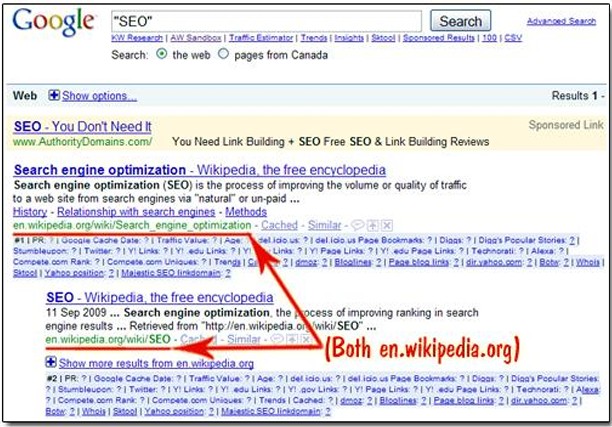Shhh don’t tell… I’m revealing to you my weapons for optimal SEO results. In this posts, I’m sharing with you the strategies that I use with my clients to get them to the top in search engine rankings.
Backlinks for Optimal SEO Results
One of the most effective ways of gaining page rank quickly lies in how many quality links lead back to your site.
One organic way of creating back links for optimal SEO results occurs when you post comments in Forums relevant to your niche – ones that allow you to put an URL in your signature, or accept your website URL in the comment form. However, this is not the strongest or the only way to generate back links – particularly if you leave “worthless” comments like: “Great post, dude.” You need to be speaking with authority even in your comments.
An even better way to create incoming links for SEO to your website: Write 350-700 word articles for your niche, and submit them to Article Directories – starting with HubPages.
Build the articles around a juicy key phrase you’ve researched. Put the key phrase in the Title, and again in the first paragraph (preferably the first sentence.)
Add a Resource box that includes a simple link to your site (do not put any links in the article body!) Make the Resource box all about what your reader needs; not about your accomplishments.
Click here to see an example of a resource page on an article directory website for optimal SEO results. The incoming links SEO to my website is at the top right.
Sitemaps for Optimal SEO Results
If your site is bigger than a page or two, it is absolutely crucial to have a Sitemap, in order to help Google to discover pages their Search Bots might not otherwise find.
Sitemaps are written in XML markup language – but relax. There are “third party” tools for generating one quickly. (And you would call the actual file “Sitemap.xml”.
There is one more very special use for Sitemaps many people are not aware of: you can create ones specially designed to feed Google the facts on non-standard content, including video, mobile, News, Code Search, and geographical (KML) information.
Google’s Webmaster Guidelines offers a list of third-party Sitemap generators. One of the easiest ones to use, however, is Free Sitemap Generator – you don’t have to know a word of code, and FSG will even ping Google and Bing for you.
If you have a WordPress “blog” web site, creating a Sitemap is even easier with the XML Sitemap plugin! Install really is a one-click process – but don’t forget to click on the link to configure the Sitemap (you just fill in your key information.) The All In One SEO plugin comes with a Sitemap.
Double Listings and Site Links
What is a “Double Listing”? Well, it looks like this…

When you see a site that is double-listed at the top of the page rankings, you know it is considered by Google to be an “ultimate authority site”.
A “series” will sometimes get you a coveted Double Listing. (Google loves series.) There’s a technique to it, however… Go to your cPanel and check your stats. See which pages are bringing in traffic. Work with keywords and topics on those pages. Become the authority on one subject – better yet, on one unique portion of a subject).
You can also keep that one phrase – in our screenshot, above, it’s obviously “Search Engine optimization” – and keep regularly writing “updates” and new pages on the subject. Or you can do a slight variation, especially if you’re not just writing web site pages, but articles:
- Make sure the topic you’re going to write about can broken very naturally into separate modules (i.e. articles)
- Start each article or post with the same topic name but add a distinguishing phrase (your primary key phrase for that individual article or post)
(E.G.
“Article Marketing: Top 10 Directories”
“Article Marketing: How Many Words?”
“Article Marketing: Writing Killer Copy”)
- When writing the Title in HTML, reverse this: “Top 10 Directories: Article Marketing”
And, of course, it goes without saying that you’re going to be writing strong, original content.
Raising The Bar On Click Throughs
The best way to improve conversions from Click Throughs for optimal SEO results is the simplest of all: context.
If your keyword phrases don’t attract the right people – paying customers – then it doesn’t matter how great a key phrase it was; or how much it’s improved your rankings and click throughs.
It’s not doing its job.
The key is to pick key phrases that represent what you and your customers are all about exactly. Both your click throughs and your conversions will organically grow, as a result.
You have to anticipate the user’s purpose in visiting your site.
And keep watching your stats – even just the ones in your cPanel – to see which pages are working; and which are not.
Submitting Your Site
While Google holds top spot by miles for Internet Marketers, submitting your site to other directories is a small but important part of making the most of your SEO efforts. Not only will you have new venues to be listed in, but it will help push up your Google rankings.
While you can submit your site directly to Yahoo (for a hefty $299 per year), chances are you’ll quickly get indexed by them anyway. However, there are 2 directories and Search Engines where you may wish to submit your site(s) manually.
You can also submit your site directly to Google – but in my experience, that’s an unnecessary waste of time. Google indexes new sites surprisingly quickly – especially if they’re optimized correctly and contain fresh, ever-changing content. (I’ve had sites indexed with a few days!)
The Curlie Directory for Optimal SEO Results
The Curlie Directory Project is the most important directory, when it comes to site submission. Not only is it the largest, it’s 100% human-edited – so it sometimes take a while to see your site appear in their listings.
Go to the Curlie main page, and click on “Suggest URL”, to submit your site.
Take note of and follow their guidelines scrupulously.
Has Your Site Met BING yet?
Are you familiar with Microsoft’s Bing. You can submit your site to Bing, logging in with your Windows Live ID. Submit your Site URL and Sitemap URL. (The latter is not compulsory, but highly recommended.)
You will have to “verify” it, and it will need to be validated before it’s added. (For complete instructions, check out Bing’s help center.)
Submit your site to any Directory or two specific to your industry or niche – and you’re done. Don’t bother submitting it to zillions and zillions of Search Engines and Directories, because these are really “small potatoes” beside the handful of main engines – which means by the time their editors get around to checking your site (assuming they have real editors) Google will have indexed you long ago.







